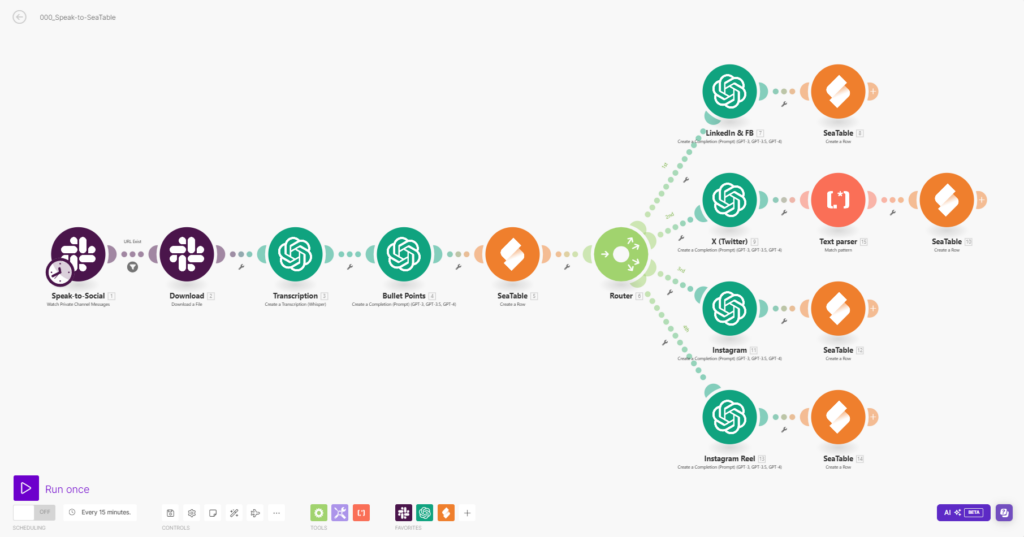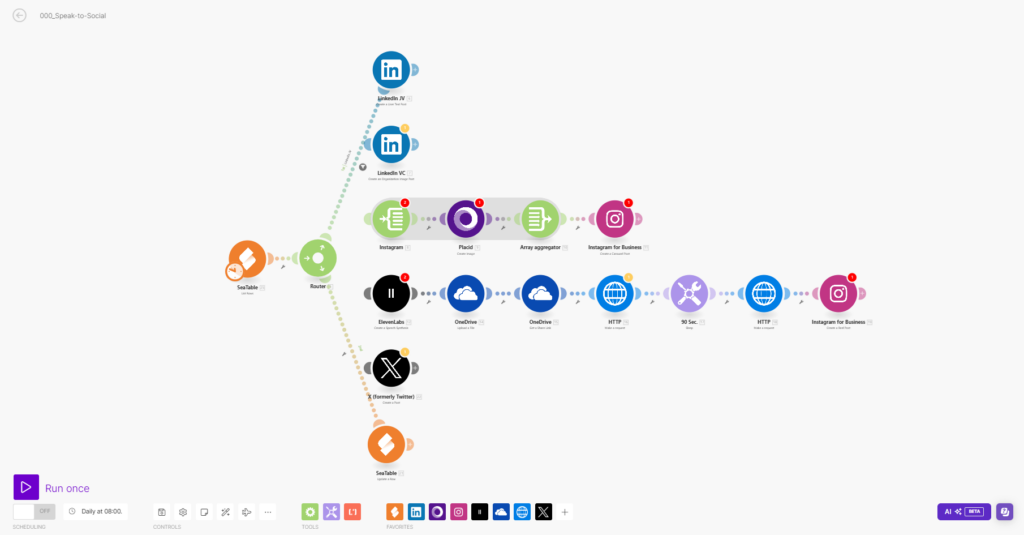“If your employees are still entering data manually, you’re not just wasting time – you’re gambling away your future.”
In a world where speed and efficiency make the difference between success and failure, the question is: are you already using the full potential of AI-supported process automation, or are you lagging behind the competition?
The power of voice: When words become workflows
Imagine setting complex business processes in motion with a simple voice command. Sounds utopian? Welcome to the reality of intelligent business process optimization. Modern AI systems transform spoken words into structured data, automated workflows, and precise analyses – all in real-time.
AI-powered process automation is like a highly efficient assembly line in a modern factory: it takes raw information, processes it intelligently and delivers customized outputs for different departments.

The process in detail: from voice recording to automated action
Let’s take a look at the actual process:
- Voice recording: A user records a voice message stored in Slack.
- Processing: The recording goes through several steps:
-
- Downloading the audio file
- Transcription of the spoken content
- Creation of bullet points to summarize the message
- Data storage: The processed information is stored in a no-code platform for data management.
- Distribution: A router system decides how the information is further processed.
- Platform-specific preparation: The content is adapted depending on the target platform (e.g. LinkedIn, Twitter, Instagram):
-
- For LinkedIn: Creation of detailed posts
- For Twitter: Generation of several related tweets
- For Instagram: Creation of image carousels or reels with text-to-speech generation
- Publication: The prepared content is automatically posted on the respective platforms
- Feedback: SeaTable receives confirmation that the process has been completed.
This entire process is fully automated after the initial release. The combination of powerful language models (LLMs) and intuitive no-code interfaces democratizes access to AI technologies and accelerates digital transformation in companies of all sizes.

From construction sites to operating theatres: AI is revolutionizing industries
The potential applications of this technology are almost limitless:
- Construction site inspection: A site manager speaks his observations into his smartphone. Seconds later, everyone involved receives a detailed report, including automatically generated checklists and photo documentation.
- Operation protocol: Surgeons dictate during the operation. AI not only creates the protocol, but also generates billing codes and updates the electronic patient file – all in compliance with the GDPR.
- Quality control in production: voice-controlled quality checks update control charts in real time and automatically trigger warning messages if necessary.
- Maintenance and servicing: technicians report problems by voice. The system automatically creates maintenance orders and checks the availability of spare parts.
- Customer feedback processing: customer comments are immediately categorized, prioritized and converted into personalized responses.
Thinking outside the box: the future of smart business automation
The true strength of these systems lies in their flexibility and expandability. Whether it’s email automation, AI-supported text analysis or seamless integration with existing industry software – the possibilities are endless.
The rapid evolution of Large Language Models (LLMs) is revolutionizing AI-supported process automation. The introduction of GPT-4 and its variant GPT-4o1, which has an impressive IQ of 120, opens up completely new possibilities for no-code platforms. This development makes it possible for non-programmers to create complex automation solutions that were previously only possible with extensive programming knowledge.
The rise of citizen developers
A key trend in this development is the rise of “citizen developers”. These are employees who are not professional programmers, but are nevertheless able to create complex applications and automation solutions using no-code platforms.
Citizen developers have several advantages:
- They take the pressure off the IT department by implementing simpler projects themselves.
- As subject matter experts, they can often develop suitable solutions for their departments more quickly.
- They promote innovation by introducing new solutions from the user’s perspective.
- They act as a bridge between the specialist departments and IT, which improves communication and mutual understanding.
Thanks to AI-supported no-code platforms, citizen developers can now develop solutions that would have required a team of professional developers just a few years ago. This not only democratizes software development, but also accelerates the digital transformation in companies.
The key to success: understanding and vision
Companies do not need a team of AI experts to successfully implement this technology. The decisive factors are:
- a basic understanding of AI and effective prompting
- the ability to rethink and optimize processes
- a focus on true automation, not mere digitalization
It’s not about transferring old processes to new platforms. It’s about fundamentally redesigning work.
Leadership in the age of the AI revolution
Successful leaders in the era of AI automation are characterized by the following skills:
- Technological understanding and willingness to innovate
- Ability to redesign work processes
- Promotion of a culture of continuous learning
- Support and promotion of citizen developers
When introducing AI-supported no-code platforms, managers should:
- Draw parallels with the introduction of email and Microsoft Office in the past
- Emphasize that, as with previous technological disruptions, these new tools can and must be learned
- Emphasize the opportunities for personal and professional development that come with mastering these technologies
Effective communication strategies are crucial:
- Regular updates on progress and benefits
- Open forums for employee questions and concerns
- Training on how to use the new systems
- Showcases of successful projects by Citizen Developers
Recall previous technology transitions such as the introduction of email and office suites to allay fears. Show concrete examples of how no-code AI tools can make daily work easier, similar to how Office programs did.
Conclusion: The future belongs to the pioneers
The question is not whether AI will change your industry, but when and how radically. The processes and application examples presented here show that the future of work has already begun. It is up to you whether you actively shape it or are overrun by it.
Are you ready to revolutionize your business processes? The time to act is now. Harness the power of AI-powered no-code platforms to catapult your company to the forefront of innovation. Nurture your Citizen Developers and create a culture of continuous improvement and automation.
The future is speaking – listen and respond with innovation!






